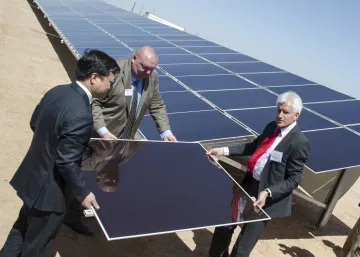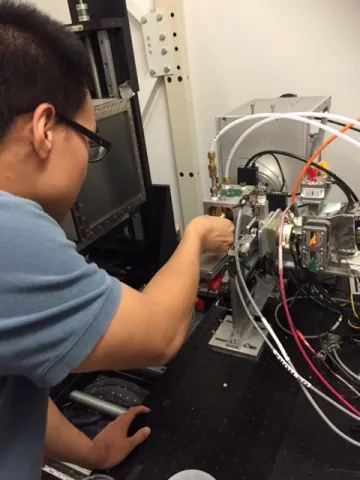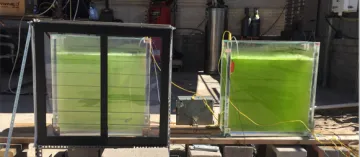
AzRISE / TEP Test Yard
Arizona Research Initiative for Solar Energy (AzRISE): Testing and Evaluation of Solar Energy and Grid Devices
The solar test yard, a research facility shared between AzRISE, a UA College of Engineering solar energy research initiative, and Tucson Electric Power (TEP), recently celebrated its 15th anniversary as well as over ten years of collaboration with the University of Arizona. As a partner to the Institute for Energy Solutions (IES), the University of Arizona’s AzRISE is dedicated to the study and improvement of photovoltaic (PV) system performance and resilience under a range of operational environments.. Led by Dr. Kelly Simmons-Potter, University of Arizona, students and faculty collaborate with TEP and with the solar industry and renewable energy stakeholders from all corners of the world. The research conducted by AzRISE is an invaluable contributor to the increasing prevalence and successful implementation of solar energy generation spanning utility to individual homeowner scales.
The solar test yard offers an evaluation of solar photovoltaic technology performance under field-relevant conditions using state-of-the-art, robust data collection techniques and remote access. With a capacity for over 600 PV modules and a history of interaction with over 20 manufacturers the test yard focuses on discovering the best ways to generate, store and distribute solar energy earning international acknowledgement as a valuable scientific resource for solar energy research and large-scale system development.
AzRISE facilities also includes an accelerated degradation chamber that enables in-situ monitoring of full-scale PV module and battery storage system performance subjected to a range of controlled environmental conditions . This unique equipment tests the performance limits of solar energy systems that are critical in estimating the long-term return-on- investment for utilities, industries, and individuals who install these systems. The degradation chamber models the climates and conditions of areas all over the world, testing the durability of PV modules under specific stressors in order to improve the technology. Moreover, such information is critical in providing more accurate long-term forecasts of power generation.as a whole.
In the past 10 years, the installed solar energy in the US has grown at an annual rate of 59%, reaching an installed capacity of 60 GW in 2018 (SEIA, 2018). The research done by AzRISE and TEP supports this growth, providing a scientific foundation for the development of new PV and storage technologies and management options to further broaden the application of this renewable energy generation option into the future.
“We’re excited to contribute to Arizona leadership in renewable energy implementation and its reliable application. Our upgraded test-yard data collection infrastructure, degradation facilities, and our newly commissioned battery test capabilities expand our opportunity to work with stakeholders to develop and field highly-efficient and resilient technologies.” - Professor Kelly Simmons-Potter, ECE and OSC, UA.
"New performance degradation results are already providing insight into the development of more robust, long-term power generation forecasting in concert with UA’s Hydrology and Atmospheric Sciences Department.” - Professor B. G. Potter, Materials Science and Engineering, UA.
CPV/CSP Hybrid Solar Energy
The CPV/CSP hybrid solar energy system performs two functions at the same time; using PV at high efficiencies and storing hot fluid in that CSP system that generates both electricity and storable heat within the same system. Researchers at the University of Arizona’s College of Optical Sciences are working with Sharp Labs to develop this hybrid solar converter based on CSP trough concentrator design that leverages the advantages of both PV and CSP to use each portion of the solar spectrum. “This could enable utilities to provide dispatchable, on-demand, solar electricity at low cost even when the sun does not shine.”
Professor, College of Optical Sciences

Organic Thermoelectrics
We propose a paradigm shift in design of highly efficient thermoelectric materials and device platforms that will overcome the challenges inherent to existing state-of-the-art approaches, namely efficiency, toxicity, cost, and flexibility. The ability of thermoelectric materials to convert waste heat into useful electrical energy is essential for increasing the efficiency of small-scale power supply technology and for active thermal management applications.
Market projections for thermoelectrics amount to US$1 billion by 2024 if suitable materials can be developed. End user and application sectors include waste heat recovery systems in vehicles to improve fuel economy, improved solar energy conversion efficiency in tandem solar-thermal devices, wireless sensor networks for water and food supply quality monitoring powered by thermo-generators to minimize battery lifetime and reliability issues, wearable consumer products and sensors that can be operated by temperature differentials from body heat, and energy harvesting in effluent streams. Thus, low cost and efficient thermoelectric devices would provide a disruptive technology that has the potential to revolutionize distributed and renewable power-generation, water treatment systems and consumption.
Dr. Erin Ratcliff
Assistant Professor, Department Materials Science and Engineering
Dr. Oliver Monti
Associate Professor, Department Chemistry and Biochemistry
Associate Professor, Department of Physics

Solar Glass
Capturing solar radiation to accelerate algal growth, store energy, and assist in water re-use and purification.
Biodiesel and jet fuel produced from microalgae has emerged as one of the most promising renewable technologies due to its ability to produce high energy density oil and absorb CO2. An interdisciplinary group of investigators have identified that the efficiency of algal photosynthesis depends on the spectral overlap between solar irradiation and chloroplast absorption. They have demonstrated that their Solar Glass technology, equipped with HOEs (holographic optical elements) which are extremely flexible in their design, can help to provide “energy balance” to greenhouse systems which are typically not energy balanced.
The solar spectrum is directed toward photovoltaic (PV) cells, integrated into the Solar Glass, which can: i) provide power for additional illumination during the day (for accelerated growth); ii) provide energy to battery storage to provide longer growing periods (using LEDs at night for illumination); or iii) provide energy for photoelectrocatalytic assisted-purification of waste water from the greenhouse environment. The goal of the research is to develop a greenhouse solar window that will maximize the transmission of incoming solar radiation near the peak in the chloroplast absorption and convert the remaining solar spectrum that is less useful for biofuel generation into electricity that can be used to enhance the algal growth.
Dr. Lloyd Lacomb
Research Professor, College of Optical Sciences
Dr. Kimberly Ogden
Professor, Department of Chemical and Environmental Engineering
Dr. Neal Armstrong
Regents Professor of Chemistry/Biochemistry & Optical Sciences,
and Associate Vice-President in Research, Discovery and Innovation at the University of Arizona.
The IESTE Project
The Clean Energy Economy Executive Order signed by President Biden on December 8, 2021 includes ambitious goals of achieving carbon pollution-free electricity by 2030 and 100% zero-emission vehicle acquisitions by 2035. Meeting President Biden’s Clean Electricity Goals will require nearly 700,000 new Solar Energy Workers by 2035. And as directed by the Executive Order, this workforce needs to be climate- and sustainability-focused. The solar industry sector also needs to increase efficiency and reduce installation and operating costs.
The University of Arizona along with Pima Community College, local industry, and utilities is working to develop a novel Teamed Internship & Certificate Program for Solar Technicians and Engineers to educate underrepresented groups in Solar Technology and promote emerging career opportunities.
Dr. Greg Ogden
Research Professor, Department of Chemical & Environmental Engineering
Jacqueline Bruhn
Program Manager, SBAR & IESTE Project
Greg Wilson
Dean of Applied Technology, Pima Community College
